Table of Contents
ToggleWhat Kind of Lights Do Badminton Courts Use?
When it comes to lighting badminton courts, several types of fixtures are used to ensure optimal visibility and performance.
Flood Lights
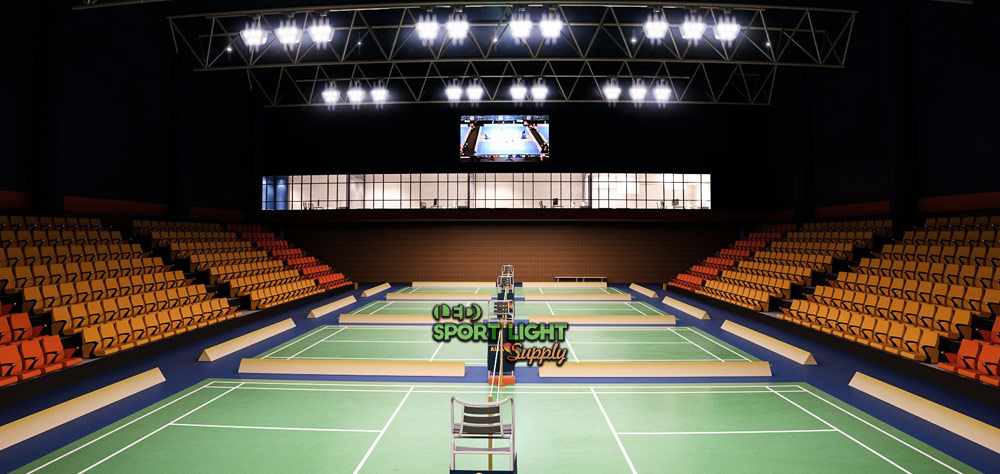
Flood lights are a versatile and popular choice for both indoor and outdoor badminton courts. These lights are designed to provide broad and even illumination, making them ideal for covering large areas with consistent brightness. Typically mounted on high poles or fixtures, flood lights use an extensive beam angle to ensure that the entire court is illuminated uniformly. This wide coverage helps in minimizing shadows and glare, which can be disruptive during play. In indoor settings, flood lights are often installed on the ceiling or high on the walls, while outdoor courts benefit from flood lights mounted on tall poles around the perimeter. The ability to spread light evenly across the court ensures that players can see clearly, improving their performance and reducing the risk of accidents.
UFO LED High Bay Lights
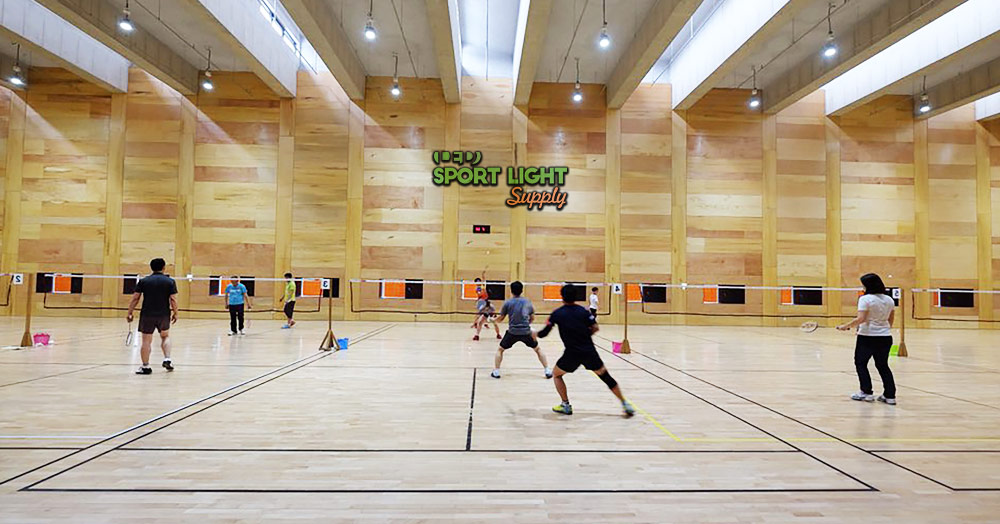
UFO LED high bay lights are particularly well-suited for indoor badminton courts with high ceilings. These fixtures are named for their distinctive, compact, circular design that resembles a UFO. They are engineered to deliver intense and concentrated illumination, making them effective for large indoor spaces. The high lumen output of UFO LED high bay lights ensures that they can light up the court evenly from a significant height, which is essential for achieving uniform lighting in spacious environments. These lights are designed to be energy-efficient and have a longer lifespan compared to traditional lighting options, making them a cost-effective choice for indoor sports facilities.
Spotlights
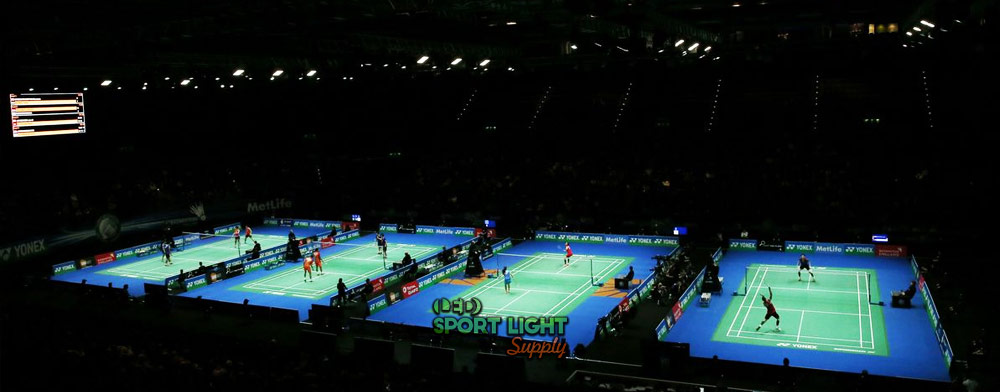
Spotlights are used more selectively compared to flood lights and UFO LED high bay lights. They provide focused illumination that can be directed to specific areas of the court, such as the net or the sidelines. This targeted lighting is useful for highlighting particular sections of the court during crucial moments or for enhancing visibility in specific areas. While spotlights are less common than flood lights, they can be an effective addition for precision lighting needs. Their adjustable nature allows for customization based on the specific requirements of a game or training session.
High Mast Lights
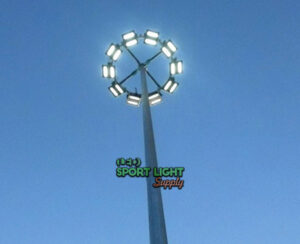
High mast lights are predominantly used for outdoor badminton courts where extensive illumination is required. Mounted on very tall poles, these lights are designed to provide high-intensity lighting over a large area. The substantial height of the poles allows for broad coverage and ensures that the entire court is evenly lit. High mast lights are particularly effective in outdoor settings where achieving adequate brightness and coverage is crucial. These fixtures are built to withstand outdoor conditions and are often equipped with weather-resistant features to maintain their performance over time.
Indoor Badminton Court Lighting Design and Layout
Designing the lighting for indoor badminton courts involves careful consideration of various factors to ensure optimal visibility and comfort for players.
Direct or Indirect Lighting
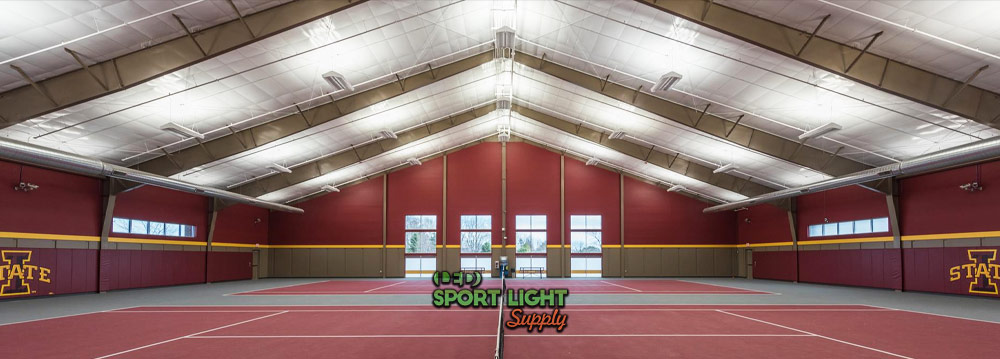
The choice between direct and indirect lighting has a significant impact on how light is distributed across the court. Direct lighting involves fixtures that shine light directly onto the court from above, providing bright and focused illumination. This type of lighting is effective for ensuring that the court is well-lit with minimal shadows. Indirect lighting, on the other hand, bounces light off the ceiling or walls, creating a more diffuse and evenly spread illumination. This method can help to reduce glare and create a more comfortable playing environment. The choice between direct and indirect lighting depends on the desired lighting effect and the layout of the court.
Ceiling Height of Badminton Hall
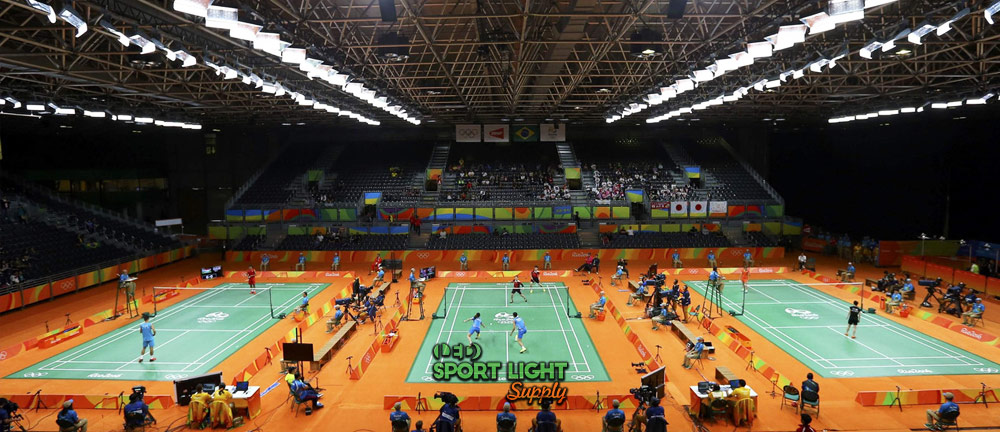
The height of the ceiling in a badminton hall plays a critical role in determining the appropriate lighting design. For high ceilings, UFO LED high bay lights are commonly used due to their ability to provide effective illumination from a considerable height. Proper fixture placement is essential to ensure that the light reaches the court adequately. In contrast, lower ceilings may require different types of fixtures or adjustments to achieve the desired lighting levels. The height of the ceiling influences the type and positioning of lights to ensure even coverage and optimal visibility.
Reflective Index of Surfaces
The reflective index of the surfaces within the badminton hall, including the walls, ceiling, and floor, affects how light is distributed. Surfaces with a high reflective index enhance the spread of light and can reduce the number of fixtures needed to achieve the desired brightness. For example, white or light-colored walls and ceilings will reflect more light and contribute to a brighter environment. Conversely, surfaces with a low reflective index, such as dark-colored walls, may absorb more light and require additional fixtures to maintain adequate illumination levels.
Distance Between LED Lights
The spacing of LED lights on the court ceiling is crucial for achieving uniform illumination. If LED lights are placed too far apart, it can result in uneven lighting with dark spots or shadows on the court. Proper calculation of the distance between fixtures is necessary to ensure that the entire court is lit evenly. Factors such as the type of LED lights used, their beam angle, and the overall lighting design must be considered to determine the optimal spacing for effective illumination.
Beam Angle
The beam angle of lighting fixtures determines how light is distributed across the court. A wider beam angle allows for more extensive coverage but may result in lower intensity, while a narrower beam angle focuses light more directly on specific areas. Selecting the appropriate beam angle is essential for balancing coverage and brightness. For badminton courts, the goal is to achieve a uniform distribution of light that minimizes shadows and provides clear visibility for players.
Heat Emitted by LED Lights
Heat emission is an important consideration when selecting lighting fixtures. While LEDs produce significantly less heat compared to traditional lighting options, proper ventilation and heat dissipation are still crucial for maintaining performance and extending the lifespan of the fixtures. High heat levels can affect the efficiency and longevity of LED lights, so ensuring that fixtures have adequate cooling mechanisms is essential for optimal operation.
Number of LED Lights Needed
Determining the number of LED lights required involves evaluating factors such as the size of the court, ceiling height, and the desired illumination levels. Accurate calculation ensures that the court is adequately lit without excessive energy consumption or light pollution. Overestimating or underestimating the number of lights can lead to issues such as uneven lighting or increased operational costs. Proper planning and assessment are necessary to achieve the right balance of lighting for the court.
Outdoor Badminton Court Lighting Design and Layout
Designing lighting for outdoor badminton courts involves addressing unique challenges to ensure proper visibility and performance.
Outdoor Pole Height
The height of outdoor lighting poles is crucial for providing adequate illumination and minimizing shadows. Tall poles are necessary to achieve comprehensive coverage of the court and ensure that the light reaches all areas effectively. The height of the poles must be sufficient to provide bright and even illumination while being sturdy enough to withstand environmental conditions such as wind and weather.
Number of Badminton Court Light Poles
The number of light poles required for an outdoor badminton court depends on the court’s size and the desired lighting intensity. Typically, multiple poles are used around the perimeter of the court to ensure even coverage and minimize shadows. Proper spacing and positioning of the poles are essential for achieving uniform illumination and avoiding dark spots.
Pole Position
Strategic placement of light poles is essential for achieving balanced illumination across the court. The poles should be positioned to ensure that light is distributed evenly, reducing shadows and glare. Proper pole placement helps to achieve optimal lighting conditions and enhances the playing experience.
Angle of Projection
The angle at which light is projected from the fixtures affects how it is distributed across the court. Adjusting the projection angle ensures that light is directed effectively onto the court, minimizing glare and shadows. Proper alignment of the fixtures is necessary to achieve the desired lighting effect and improve visibility.
Avoiding Light Pollution
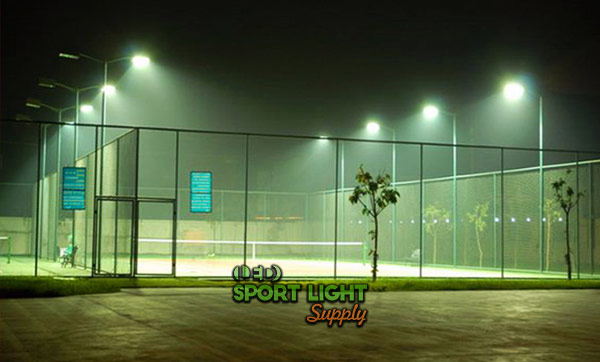 Minimizing light pollution is important for maintaining a comfortable and environmentally friendly outdoor lighting setup. Using fixtures with proper shielding and focusing light on the court helps to reduce light spill into surrounding areas. Effective management of light pollution is essential for preserving the quality of the night sky and reducing its impact on nearby residential or natural areas.
Minimizing light pollution is important for maintaining a comfortable and environmentally friendly outdoor lighting setup. Using fixtures with proper shielding and focusing light on the court helps to reduce light spill into surrounding areas. Effective management of light pollution is essential for preserving the quality of the night sky and reducing its impact on nearby residential or natural areas.
What Are the Lux and Lumen Requirements for Badminton Court Lighting?
Recreational / Badminton Club
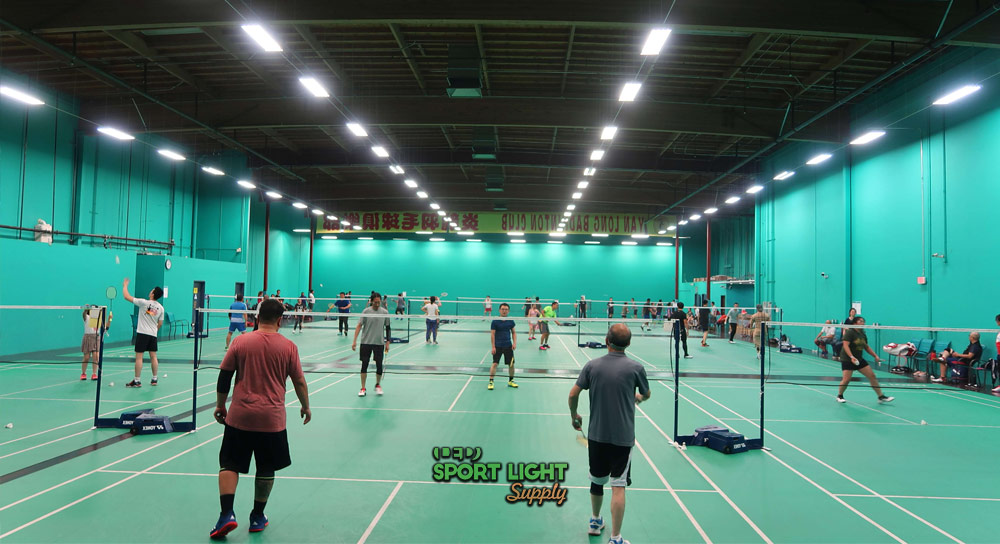
For recreational or club-level courts, a minimum lux level of 300 to 500 lux is generally adequate. This level of illumination provides sufficient visibility for casual play and ensures a comfortable environment for players. Recreational courts may not require the same intensity of lighting as higher-level facilities, but adequate brightness is still essential for enjoyable play.
High School, College, or Training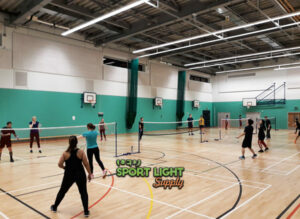
Training facilities and educational institutions require higher illumination levels to support competitive play and training activities. A minimum lux level of 500 to 750 lux is typically needed for these settings. Enhanced lighting ensures that players can perform at their best and that the court is well-lit for training sessions and educational events.
Community
Community courts, which may host local events and competitions, need around 750 to 1000 lux. This level of illumination is necessary to ensure that the court is adequately lit for both players and spectators. Higher lux levels provide a better quality of light and contribute to a more professional appearance for community events.
National and International Tournaments
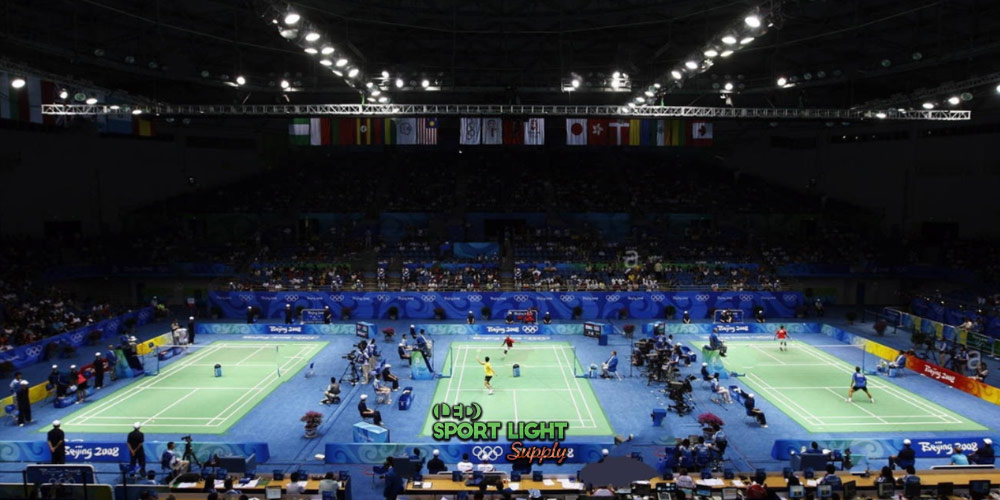
For courts used in national and international tournaments, higher illumination levels are required to meet the standards of high-level competitions. Lux levels ranging from 1000 to 1500 lux are typically needed to provide optimal visibility for players, officials, and cameras. This high level of lighting ensures that the court is well-lit for broadcast and viewing, maintaining the quality of the tournament.
What Wattage Do I Need for Badminton Court Lighting?
Indoor Lighting
For indoor badminton courts, LED high bay lights typically range from 100 to 400 watts. The specific wattage needed depends on factors such as ceiling height and the required illumination levels. Higher wattage fixtures may be necessary for large or high-ceilinged courts to achieve adequate brightness.
Outdoor Lighting
Outdoor badminton courts may require flood lights with wattages ranging from 400 to 1000 watts. The wattage needed depends on the size of the court and the desired level of illumination. Higher wattage fixtures are often used to ensure comprehensive coverage and to achieve the required lux levels.
Badminton Court Lighting Price
The cost of badminton court lighting includes several factors, such as the price of the lamps, installation costs, and running costs.
Lamp Price
The price of lighting fixtures can vary widely based on the type and quality of the lamps. LED flood lights, UFO high bay lights, and spotlights all come with different price points. Generally, LED fixtures are more expensive upfront compared to traditional lighting but offer long-term savings due to their energy efficiency and durability.
Installation Costs
Installation costs include the expense of setting up the lighting system, including labor, equipment, and any necessary adjustments. Proper installation ensures that the fixtures are correctly positioned and aligned to achieve optimal lighting. Professional installation can help avoid common issues and ensure that the lighting system performs effectively.
Running Costs
Running costs refer to the ongoing expenses associated with operating the lighting system, including electricity consumption. LED lights are known for their energy efficiency, which can significantly reduce running costs compared to traditional lighting options. Regular maintenance and efficient use of the lighting system also contribute to controlling running costs.
How to Select the Best LED Lights for Badminton Court
Choosing the right LED lights for a badminton court involves evaluating several key factors to ensure that the fixtures meet performance and quality standards.
Luminous Efficiency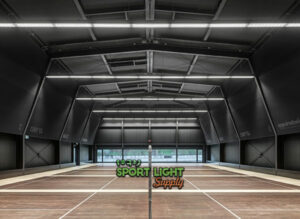
Luminous efficiency measures how effectively a light source converts electrical power into visible light. High luminous efficiency ensures that the fixtures provide bright illumination with lower energy consumption. For badminton courts, selecting LED lights with high luminous efficiency helps to achieve adequate lighting while minimizing energy costs.
Proper Beam Angle
The beam angle of the LED lights determines how light is spread across the court. A wider beam angle provides broader coverage but may reduce intensity, while a narrower angle focuses light more directly. Choosing the appropriate beam angle is crucial for achieving uniform illumination and minimizing shadows.
Lifespan
The lifespan of LED lights affects their long-term performance and maintenance needs. High-quality LEDs have a longer lifespan, reducing the frequency of replacements and associated costs. Opting for LED lights with a longer lifespan ensures reliable performance and lower maintenance requirements.
Color Temperature
Color temperature affects the quality and appearance of the light. For badminton courts, a color temperature of around 4000K to 5000K is typically preferred, as it provides bright, natural light that enhances visibility and reduces eye strain. Choosing the right color temperature ensures a comfortable and effective playing environment.
Heat Dissipation System
Effective heat dissipation is essential for maintaining the performance and longevity of LED lights. High-quality fixtures are designed with efficient cooling systems that prevent overheating and ensure stable operation. Proper heat dissipation helps to extend the lifespan of the lights and maintain consistent performance.
Modular Design
A modular design allows for easy maintenance and upgrades of the lighting system. LED lights with a modular design can be easily serviced or replaced without affecting the entire system. This feature contributes to long-term reliability and flexibility in managing the lighting setup.
Waterproof Features
Waterproof features are important for outdoor lighting fixtures to withstand environmental conditions. LED lights with waterproof ratings are protected against moisture and weather, ensuring reliable performance in outdoor settings. Proper waterproofing helps to prevent damage and extend the lifespan of the fixtures.
Height
The height of the LED lights affects their coverage and effectiveness. For indoor courts, the height of the fixtures should be appropriate for the ceiling height to achieve optimal illumination. Outdoor lights must be mounted at sufficient heights to provide comprehensive coverage and minimize shadows.
Where Can We Buy Badminton Court Lighting in India?
Finding the right supplier for badminton court lighting in India involves considering reputable companies and distributors specializing in sports lighting solutions. Various suppliers offer a range of lighting options, including LED flood lights, UFO high bay lights, and other fixtures suitable for both indoor and outdoor courts. Researching local suppliers, comparing products, and reviewing customer feedback can help in selecting reliable and cost-effective lighting solutions.
Indoor & Outdoor Badminton Court Lighting Standards
Adhering to lighting standards ensures that badminton courts meet performance and safety requirements.
Lux Standard
Lux standards specify the required illumination levels for different types of badminton courts. Recreational courts, training facilities, community courts, and tournament venues each have specific lux requirements to ensure adequate lighting for players and spectators.
Lighting Uniformity Requirement
Lighting uniformity refers to the evenness of illumination across the court. Uniform lighting helps to reduce shadows and ensure consistent visibility, which is crucial for fair play and accurate performance evaluation.
Color Temperature Standard
Color temperature standards specify the range of color temperatures that are suitable for sports lighting. For badminton courts, a color temperature of around 4000K to 5000K is typically recommended to provide bright, natural light.
CRI and TLCI
Color Rendering Index (CRI) and Television Lighting Consistency Index (TLCI) are metrics that measure the quality of light in terms of color accuracy. High CRI and TLCI values ensure that colors are rendered accurately, which is important for both players and viewers.
Glare
Glare control is essential for ensuring that lighting does not cause discomfort or impair visibility. Proper fixture design and placement help to minimize glare and create a comfortable playing environment.
Flicker-Free
Flicker-free lighting prevents fluctuations in light intensity that can cause visual discomfort and affect performance. Choosing fixtures with flicker-free technology ensures stable and consistent lighting.
Instant On/Off
Instant on/off functionality ensures that lights reach full brightness immediately without any warm-up time. This feature is important for maintaining consistent lighting conditions and avoiding delays during play or training.
Why Using LED Flood Lights in Badminton Courts?
LED flood lights offer several advantages for badminton court lighting, including energy efficiency, durability, and superior illumination quality. Their ability to provide broad and even coverage makes them ideal for covering large areas, and their low heat emission helps to maintain a comfortable playing environment. Additionally, LED flood lights have a longer lifespan and lower running costs compared to traditional lighting options, making them a cost-effective choice for both indoor and outdoor badminton courts.
Common Mistakes When Planning the Badminton Court Lighting
Proper planning is essential for achieving effective and reliable lighting. Common mistakes can impact the quality of illumination and the overall performance of the lighting system.
Omit the Badminton Court Lighting Specification
Failing to specify lighting requirements can lead to inadequate illumination and performance issues. Proper specifications ensure that the lighting system meets the necessary standards and provides the desired lighting effect.
Wrong Installation Height
Incorrect installation height can result in uneven lighting and shadows. Proper placement of fixtures is essential for achieving balanced illumination and ensuring that the light reaches all areas of the court effectively.
Wrong Projection Angle When Installing Outdoor Badminton Court Lights
Incorrect projection angles can lead to inadequate coverage and glare. Proper adjustment ensures optimal lighting conditions and minimizes shadows and light spill.
Selecting the Badminton Court Lighting with the Cheapest Price
Choosing the cheapest lighting options without considering quality can result in poor performance and higher long-term costs. Balancing cost with quality is important for achieving satisfactory results and ensuring reliable performance.
Ordered the Wrong Color Temperature
Selecting the wrong color temperature can affect visibility and lighting quality. Choosing the appropriate color temperature ensures clear and natural lighting, enhancing the playing experience.
Lights Flickering and Fading More Often
Frequent flickering and fading may indicate issues with the fixtures or installation. High-quality lights and proper installation help to prevent these problems and ensure consistent performance.
Conclusion
Selecting the appropriate lighting for badminton courts involves a careful balance of various factors, including the type of fixtures, placement, and performance specifications. Flood lights, UFO LED high bay lights, spotlights, and high mast lights each offer unique advantages tailored to different court environments, whether indoor or outdoor. Understanding the requirements for lux levels, beam angles, and fixture heights ensures optimal visibility and performance, while considerations for energy efficiency and durability further enhance the overall value. By addressing these elements and avoiding common pitfalls, you can achieve a well-lit badminton court that supports both casual play and competitive events effectively.
